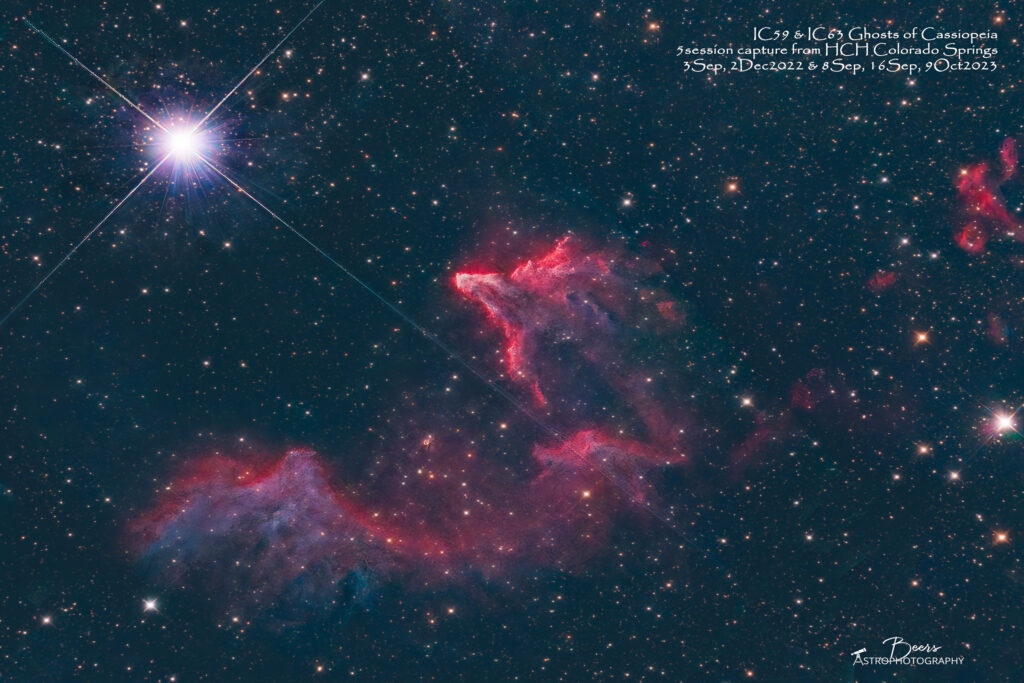I have been collecting data on IC59&IC63 Ghosts of Cassiopeia for over a year – all from the front patio, with mixed results (mostly bad!). This image is comprised of data collected over two sessions in 2022 (2Sep2022, 2Dec2022) with Big Zeus – which seemed to exacerbate the halos from Navi with its open – and three (of four) sessions in 2023 (8Sep23, 16Sep23, 9Oct23). With Halloween upon us, it seemed like the perfect time to process and post the image!
IC59 & IC63 Ghosts of Cassiopeia

IC59 & IC63 Ghosts of Cassiopeia
Target Fun Facts: The Gamma Cygni Nebula, also known as the Sadr Region or IC 1318, is a diffuse emission nebula that can be seen around Sadr (γ Cygni), the star at the center of the Northern Cross, which marks the heart of Cygnus, the Swan. Despite the name, the star and the nebula are unrelated. Even though it looks embedded in the nebulosity, Sadr (which is not captured in my image) is approximately 1,800 light years distant, while the nebula is much further away, at 4,900 light years.
The Gamma Cygni Nebula has three distinct parts, designated as IC 1318 A, B and C. The dark cloud about 20 light years thick that divides IC 1318 B and C is a dark nebula known as LDN 889. It is physically related to the emission nebula and the surrounding molecular cloud complex. The dark dust lane is responsible for the nebula’s distinctive shape, resembling that of a butterfly, which is why IC 1318 is sometimes also known as the Butterfly Nebula. IC 1318 is not to be confused with several other DSO’s with the same name: the Butterfly Nebula (NGC 6302), a bipolar planetary nebula located in the constellation Scorpius; the bright planetary Butterfly Nebula (NGC 2346) in Monoceros constellation; or the planetary nebula known as Minkowski’s Butterfly (M2-9) or the Twin Jet Nebula located in Ophiuchus.
Capture Notes: This image is composed of five night’s capture from the front patio with Big Zeus (3Sep2022, 2Dec2022) and Big Bertha (8Sep2023, 16Sep2023, and 9Oct2023). The total exposure time in this image is 26:40 hours (202x3min + 193x5min).
Session #1 (3Sep2022): ISO1600; 152x180sec; captured 3Sep2022, 2110MDT – 4Sep2022, 0526MDT. Total exposure time: 7:36 hrs.
Session #2 (2Dec2022): ISO3200; 97x300sec; captured 2Dec2022, 1823MST – 3Dec2022, 0301MST. Total exposure time: 8:05hrs.
Session #3: (8Sep2023): Gain: 158, Temp: -0°C, offset=30; 50x3min; captured 8 Sep 2023 (9Sep2023, 0259 –0538MDT). Total exposure time: 2:30hrs.
Session #4: (16Sep2023): Gain: 300, Temp: -0°C, offset=30; 36x5min; captured 16 Sep 2023 (17Sep2023, 0240 –0556MDT). Total exposure time: 3:00hrs.
Session #5: (9Oct2023): Gain: 300, Temp: -0°C, offset=30; 60x5min; captured 9 October 2023 (9Oct23, 2312 – 10Oct23, 0433MDT); (Captured but not included in the stack: 10x3min; captured 10Oct23, 0433 – 0505MDT.) Total exposure time: 5:30hrs.
Processing: Captured in SGP; stacked in APP (5session, HaOIII Color, RGGB Debayer, Camera White Balance); star removal with Starnet++; processing with LR/PS
The gallery entry, for the “rest of the story” and other images of the Ghosts (the data used to create the other images are included in this 5-session stack) is here: https://beersastrophotography.com/gallery/ic59-ic63-ghosts-of-cassiopeia/
